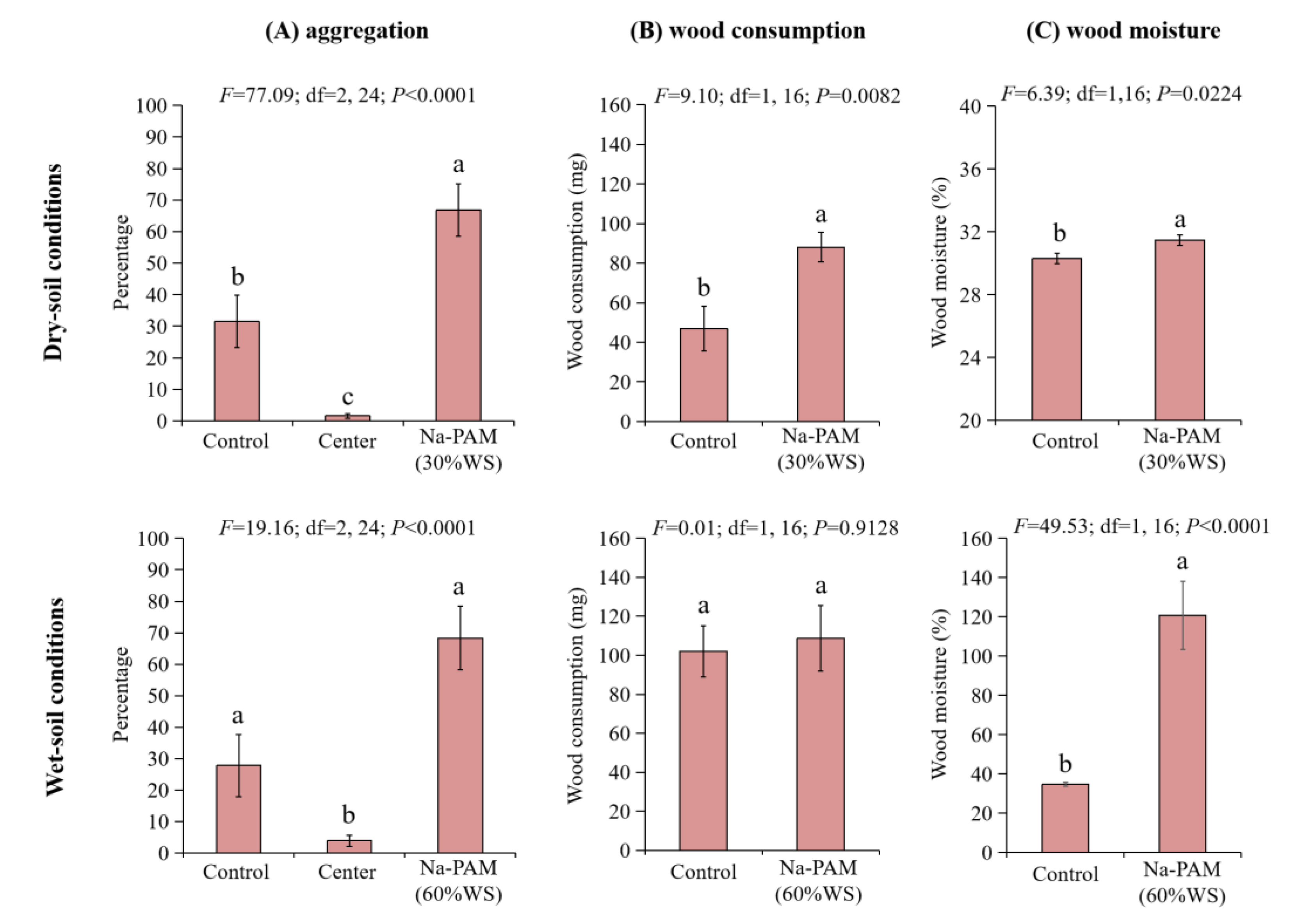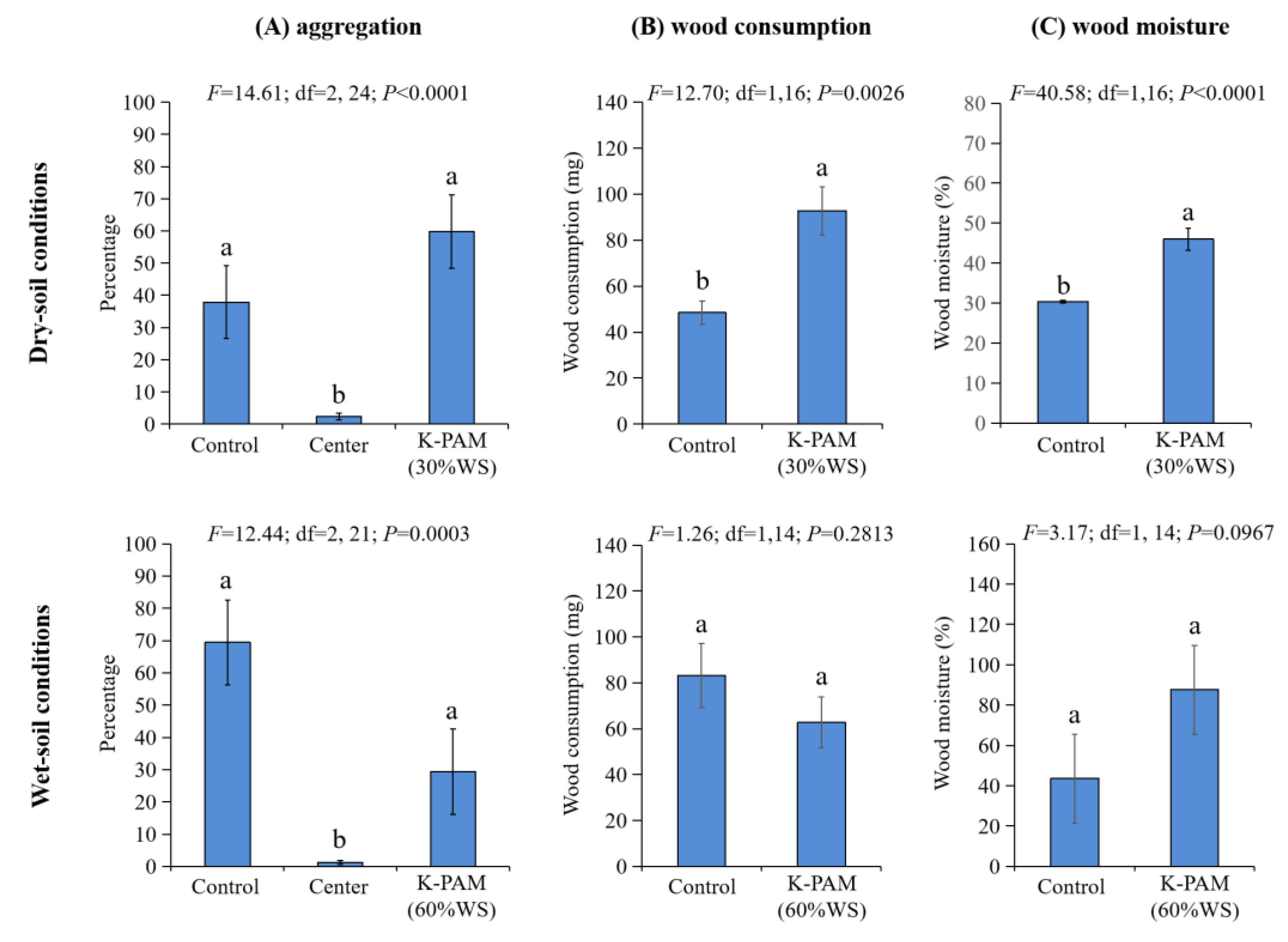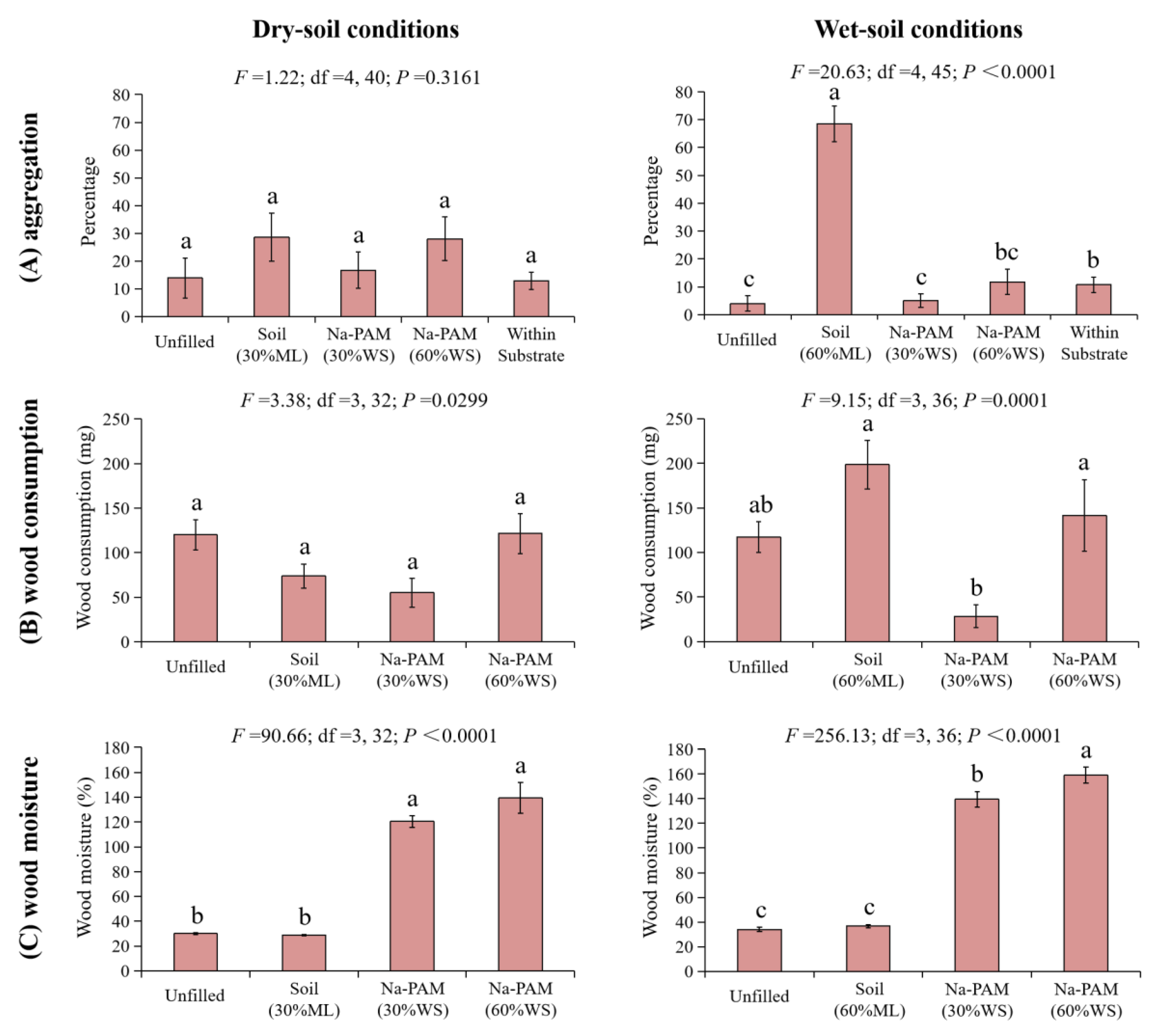Super Absorbent Polymers Buried within Dry Soil Attract Formosan Subterranean Termites (Blattodea: Rhinotermitidae)
Abstract
1. Introduction
2. Materials and Methods
2.1. Termites
2.2. Super Absorbent Polymers and Soil (Substrate)
2.3. Preference of Termites to Super Absorbent Polymers Placed within Soil
2.4. Preference of Termites to Super Absorbent Polymers Filled in Baiting Containers
2.5. Data Analysis
3. Results
3.1. Preference of Termites to Super Absorbent Polymers Placed within Soil
3.2. Preference of Termites to Super Absorbent Polymers Filled in Baiting Containers
4. Discussion
5. Conclusions
Author Contributions
Funding
Acknowledgments
Conflicts of Interest
References
- Evans, T.A.; Forschler, B.T.; Grace, J.K. Biology of invasive termites: A worldwide review. Annu. Rev. Entomol. 2013, 58, 455–474. [Google Scholar] [CrossRef] [PubMed]
- Buczkowski, G.; Bertelsmeier, C. Invasive termites in a changing climate: A global perspective. Ecol. Evol. 2017, 7, 974–985. [Google Scholar] [CrossRef]
- Rust, M.K.; Su, N.Y. Managing social insects of urban importance. Annu. Rev. Entomol. 2012, 57, 355–375. [Google Scholar] [CrossRef] [PubMed]
- Suszkiw, J. Taking aim at Formosan subterranean termites. Agric. Res. 2000, 48, 12–15. [Google Scholar]
- Zhong, J.-H.; Liu, L.-L. Experience with Coptotermes formosanus in China (Isoptera: Rhinotermitidae). Sociobiology 2003, 41, 17–26. [Google Scholar]
- Evans, T.A.; Forschler, B.T.; Trettin, C.C. Not just urban: The Formosan subterranean termite, Coptotermes formosanus, is invading forests in the Southeastern USA. Biol. Invasions 2019, 21, 1283–1294. [Google Scholar] [CrossRef]
- Evans, T.A.; Iqbal, N. Termite (order Blattodea, infraorder Isoptera) baiting 20 years after commercial release. Pest Manag. Sci. 2015, 71, 897–906. [Google Scholar] [CrossRef]
- Su, N.Y.; Puche, H. Tunneling activity of subterranean termites (Isoptera: Rhinotermitidae) in sand with moisture gradients. J. Econ. Entomol. 2003, 96, 88–93. [Google Scholar] [CrossRef]
- Cornelius, M.L.; Osbrink, W.L. Effect of seasonal changes in soil temperature and moisture on wood consumption and foraging activity of Formosan subterranean termite (Isoptera: Rhinotermitidae). J. Econ. Entomol. 2011, 104, 1024–1030. [Google Scholar] [CrossRef]
- Gautam, B.K.; Henderson, G. Wood consumption by Formosan subterranean termites (Isoptera: Rhinotermitidae) as affected by wood moisture content and temperature. Ann. Entomol. Soc. Am. 2011, 104, 459–464. [Google Scholar] [CrossRef]
- Xiong, H.; Qin, W.; Wen, X.; Sun, Z.; Wang, C. Filling voids in subterranean termite (Blattodea: Rhinotermitidae) bait stations with soil or clay improves preference and performance. J. Econ. Entomol. 2018, 111, 2303–2311. [Google Scholar] [CrossRef] [PubMed]
- Xie, Q.; Xiong, H.; Qin, W.; Wen, X.; Sun, Z.; Wang, C. Effect of polyacrylamide/attapulgite composite on foraging behaviors of Formosan subterranean termites (Blattodea: Rhinotermitidae). J. Econ. Entomol. 2019, 112, 290–299. [Google Scholar] [CrossRef] [PubMed]
- Hwang, W.; Son, D.; Chung, J.; Geumman, K.A.N.G. Trap for Controlling Termites. U.S. Patent Application No. 15/335,583, 4 May 2017. [Google Scholar]
- Geesing, D.; Schmidhalter, U. Influence of sodium polyacrylate on the water-holding capacity of three different soils and effects on growth of wheat. Soil Use Manag. 2014, 20, 207–209. [Google Scholar] [CrossRef]
- Liu, X.; Chan, Z. Application of potassium polyacrylate increases soil water status and improves growth of bermudagrass (Cynodon dactylon) under drought stress condition. Sci. Hortic. 2015, 197, 705–711. [Google Scholar] [CrossRef]
- Chen, M.; Shelton, A.M. Impact of soil type, moisture, and depth on swede midge (Diptera: Cecidomyiidae) pupation and emergence. Environ. Entomol. 2007, 36, 1349–1355. [Google Scholar] [CrossRef] [PubMed]
- Kucera, M.; Malmgren, B.A. Logratio transformation of compositional data: A resolution of the constant sum constraint. Mar. Micropaleontol. 1998, 34, 117–120. [Google Scholar] [CrossRef]
- Lax, A.R.; Osbrink, W.L. United States Department of Agriculture—Agriculture research service research on targeted management of the Formosan subterranean termite Coptotermes formosanus Shiraki (Isoptera: Rhinotermitidae). Pest Manag. Sci. 2003, 59, 788–800. [Google Scholar] [CrossRef]
- Judd, T.M. Cues Used by subterranean termite s during foraging and food assessment. In Termites and Sustainable Management; Springer: Cham, Switzerland, 2018; pp. 159–180. [Google Scholar]
- Chen, J.; Henderson, G. Determination of feeding preference of Formosan subterranean termite (Coptotermes formosanus Shiraki) for some amino acid additives. J. Chem. Ecol. 1996, 22, 2359–2369. [Google Scholar] [CrossRef]
- Castillo, V.P.; Sajap, A.S.; Sahri, M.H. Feeding response of subterranean termites Coptotermes curvignathus and Coptotermes gestroi (Blattodea: Rhinotermitidae) to baits supplemented with sugars, amino acids, and cassava. J. Econ. Entomol. 2013, 106, 1794–1801. [Google Scholar] [CrossRef]
- Saran, R.K.; Rust, M.K. Phagostimulatory sugars enhance uptake and horizontal transfer of hexaflumuron in the western subterranean termite (Isoptera: Rhinotermitidae). J. Econ. Entomol. 2008, 101, 873–879. [Google Scholar] [CrossRef]
- Esenther, G.R.; Allen, T.C.; Casida, J.E.; Shenefelt, R.D. Termite attractant from fungus-infected wood. Science 1961, 134, 50. [Google Scholar] [CrossRef] [PubMed]
- Cornelius, M.L.; Bland, J.M.; Daigle, D.J.; Williams, K.S.; Lovisa, M.P.; Connick, W.J., Jr.; Lax, A.R. Effect of a lignin-degrading fungus on feeding preferences of Formosan subterranean termite (Isoptera: Rhinotermitidae) for different commercial lumber. J. Econ. Entomol. 2004, 97, 1025–1035. [Google Scholar] [CrossRef] [PubMed]
- Cornelius, M.L. Aggregation and feeding behavior of the Formosan subterranean termite (Isoptera: Rhinotermitidae) on wood decayed by three species of wood rot fungi. Sociobiology 2014, 59, 667–680. [Google Scholar]
- Viana-Junior, A.B.; Côrtes, M.O.; Cornelissen, T.G.; de Siqueira Neves, F. Interactions between wood-inhabiting fungi and termites: A meta-analytical review. Arthropod-Plant Int. 2018, 12, 229–235. [Google Scholar] [CrossRef]
- Xiong, H.; Xue, K.; Qin, W.; Chen, X.; Wang, H.; Shi, X.; Ma, T.; Sun, Z.; Chen, W.; Tian, X.; et al. Does soil treated with conidial formulations of Trichoderma spp. attract or repel subterranean termites? J. Econ. Entomol. 2018, 111, 808–816. [Google Scholar] [CrossRef]
- Su, N.Y. Directional change in tunneling of subterranean termites (Isoptera: Rhinotermitidae) in response to decayed wood attractants. J. Econ. Entomol. 2005, 98, 471–475. [Google Scholar] [CrossRef] [PubMed]
- Bernklau, E.J.; Fromm, E.A.; Judd, T.M.; Bjostad, L.B. Attraction of subterranean termites (Isoptera) to carbon dioxide. J. Econ. Entomol. 2005, 98, 476–484. [Google Scholar] [CrossRef] [PubMed]
- Broadbent, S.; Farr, M.; Bernklau, E.J.; Siderhurst, M.S.; James, D.M.; Bjostad, L.B. Field attraction of termites to a carbon dioxide-generating bait in Australia (Isoptera). Sociobiology 2006, 48, 771–779. [Google Scholar]
- Wang, C.; Henderson, G. Clay preference and particle transport behavior of Formosan subterranean termites (Isoptera: Rhinotermitidae): A laboratory study. Insect Sci. 2014, 21, 785–795. [Google Scholar] [CrossRef] [PubMed]
- Wang, C.; Henderson, G.; Gautam, B.K. Behavioral response of Formosan subterranean termites (Isoptera: Rhinotermitidae) to soil with high clay content. J. Insect Behav. 2015, 28, 303–311. [Google Scholar] [CrossRef]
- Cornelius, M.L.; Lyn, M.; Williams, K.S.; Lovisa, M.P.; De Lucca, A.J.; Lax, A.R. Efficacy of bait supplements for improving the rate of discovery of bait stations in the field by Formosan subterranean termites (Isoptera: Rhinotermitidae). J. Econ. Entomol. 2009, 102, 1175–1181. [Google Scholar] [CrossRef] [PubMed]
- Evans, T.A. The influence of soil heterogeneity on exploratory tunnelling by the subterranean termite Coptotermes frenchi (Isoptera: Rhinotermitidae). Bull. Entomol. Res. 2003, 93, 413–423. [Google Scholar] [CrossRef] [PubMed]
- Gautam, B.K.; Henderson, G. Water transport by Coptotermes formosanus (Isoptera: Rhinotermitidae). Environ. Entomol. 2014, 43, 1399–1405. [Google Scholar] [CrossRef] [PubMed]
- Gautam, B.K.; Henderson, G. Effects of sand moisture level on food consumption and distribution of Formosan subterranean termites (Isoptera: Rhinotermitidae) with different soldier proportions. J. Entomol. Sci. 2011, 46, 1–13. [Google Scholar] [CrossRef]
- Henderson, G. The termite menace in New Orleans: Did they cause the floodwalls to tumble? Am. Entomol. 2008, 54, 156–162. [Google Scholar] [CrossRef][Green Version]
- Li, H.F.; Su, N.Y. Sand displacement during tunnel excavation by the Formosan subterranean termite (Isoptera: Rhinotermitidae). Ann. Entomol. Soc. Am. 2008, 101, 456–462. [Google Scholar] [CrossRef]
- Li, J.; Liu, L.; Zhou, H.; Li, M. Improved viability of areca (Areca catechu L.) seedlings under drought stress using a superabsorbent polymer. HortScience 2018, 53, 1872–1876. [Google Scholar] [CrossRef]
- Verma, A.K.; Sindhu, S.S.; Singh, A.; Kumar, A.; Singh, A.; Chauhan, V.B.S. Conditioning effects of biodegradable superabsorbent polymer and vermi-products on media properties and growth of gerbera. Ecol. Eng. 2019, 132, 23–30. [Google Scholar] [CrossRef]
- Yang, W.; Guo, S.; Li, P.; Song, R.; Yu, J. Foliar antitranspirant and soil superabsorbent hydrogel affect photosynthetic gas exchange and water use efficiency of maize grown under low rainfall conditions. J. Sci. Food Agric. 2019, 99, 350–359. [Google Scholar] [CrossRef]








| Super Absorbent Polymer | Abbreviation | Water Absorption at Each Saturation Level | Brand | Manufacturer | ||
|---|---|---|---|---|---|---|
| 100% a | 60% a | 30% a | ||||
| Sodium polyacrylate (cross-linked) | Na-PAM | 795.1 b | 477.1 b | 238.5 b | Sigma | Sigma Aldrich, St Louis, MO, USA |
| Potassium polyacrylate (cross-linked) | K-PAM | 355.2 | 213.1 | 106.6 | Jadreh | Zibo Jadreh Polymer Technology Co, Ltd., Zibo, China |
| Poly(acrylamide-co-acrylic acid) potassium salt (cross-linked) | P(AM/AA) | 183.9 | 110.3 | 55.2 | Sigma | Sigma Aldrich, St Louis, MO, USA |
© 2019 by the authors. Licensee MDPI, Basel, Switzerland. This article is an open access article distributed under the terms and conditions of the Creative Commons Attribution (CC BY) license (http://creativecommons.org/licenses/by/4.0/).
Share and Cite
Xie, Q.; Jin, Z.; Lin, W.; Xue, K.; Chen, X.; Zhao, K.; Wen, X.; Wang, C. Super Absorbent Polymers Buried within Dry Soil Attract Formosan Subterranean Termites (Blattodea: Rhinotermitidae). Forests 2019, 10, 591. https://doi.org/10.3390/f10070591
Xie Q, Jin Z, Lin W, Xue K, Chen X, Zhao K, Wen X, Wang C. Super Absorbent Polymers Buried within Dry Soil Attract Formosan Subterranean Termites (Blattodea: Rhinotermitidae). Forests. 2019; 10(7):591. https://doi.org/10.3390/f10070591
Chicago/Turabian StyleXie, Qinxi, Zhengya Jin, Wei Lin, Kena Xue, Xuemei Chen, Kai Zhao, Xiujun Wen, and Cai Wang. 2019. "Super Absorbent Polymers Buried within Dry Soil Attract Formosan Subterranean Termites (Blattodea: Rhinotermitidae)" Forests 10, no. 7: 591. https://doi.org/10.3390/f10070591
APA StyleXie, Q., Jin, Z., Lin, W., Xue, K., Chen, X., Zhao, K., Wen, X., & Wang, C. (2019). Super Absorbent Polymers Buried within Dry Soil Attract Formosan Subterranean Termites (Blattodea: Rhinotermitidae). Forests, 10(7), 591. https://doi.org/10.3390/f10070591






